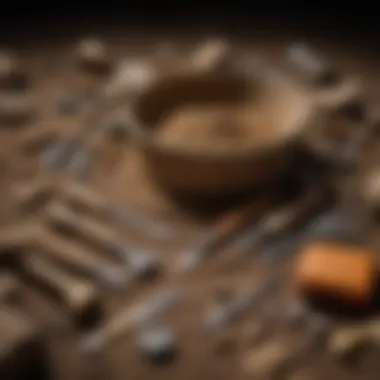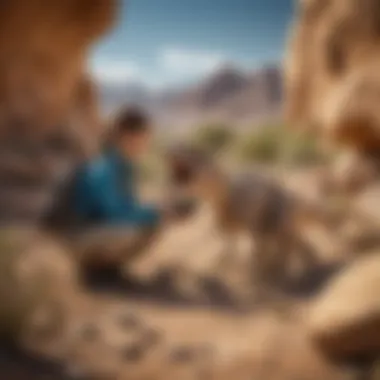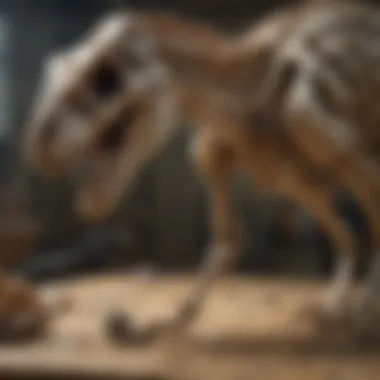Unveiling the Wonders of Paleontology: The Definitive Guide to Junior Paleontologist Kits


Rock and Fossil Identification
In the fascinating realm of paleontology, rock and fossil identification play a vital role in unraveling the mysteries of our ancient Earth. Understanding the types of rocks and fossils is paramount for aspiring junior paleontologists. Rocks can range from sedimentary, igneous to metamorphic, each with unique characteristics that aid in identification. Fossils, on the other hand, are the preserved remains or traces of ancient organisms, such as dinosaurs, plants, or marine life. To identify these specimens, one needs to look for key characteristics like texture, color, shape, and any distinct markings. Having the right tools, including brushes, chisels, and magnifying glasses, is essential for a meticulous examination of rocks and fossils to uncover valuable insights into prehistoric life.
Introduction to Paleontology
Paleontology, the study of ancient life through fossils, plays a pivotal role in unraveling Earth's history and understanding the evolution of life forms. In the context of this article, the Introduction to Paleontology serves as the foundation for exploring the world of junior paleontologist kits. By shedding light on the significance of paleontological studies, readers can grasp the essence of delving into the mysteries of prehistoric life and learn about the tools and processes that paleontologists employ to piece together the puzzle of the past. This section sets the stage for a journey into the fascinating field of paleontology, offering a glimpse into the wonders waiting to be uncovered.
Defining Paleontology
Study of Fossils
The study of fossils forms the backbone of paleontology, providing valuable insights into the morphology, behavior, and environment of ancient organisms. Fossils are the preserved remains or traces of once-living organisms, offering a snapshot of life from millions of years ago. Understanding the study of fossils allows paleontologists to reconstruct the past and trace the evolutionary history of various species. By analyzing fossil records, scientists can piece together the complexities of ancient ecosystems and track changes in biodiversity over time. The study of fossils is a fundamental aspect of paleontological research, enabling us to glimpse into the distant past and unlock the secrets hidden within Earth's ancient layers.
Understanding Prehistoric Life
Exploring prehistoric life delves into the behaviors, adaptations, and ecological roles of extinct organisms that thrived millions of years ago. Understanding prehistoric life involves studying fossilized remains, ancient environments, and the interactions between organisms in long-lost ecosystems. By piecing together clues from fossils and geological records, paleontologists reconstruct the world as it existed before human civilization. This branch of paleontology bridges the gap between past and present, allowing us to connect with the diverse array of life forms that inhabited Earth throughout its history.
Role in Evolutionary Biology
Paleontology plays a crucial role in evolutionary biology by providing tangible evidence of species evolution and biological diversity over time. By analyzing evolutionary patterns preserved in the fossil record, scientists can track the emergence of new species, the extinction of others, and the mechanisms driving evolutionary change. The study of fossils helps us understand how organisms adapt to environmental shifts, compete for resources, and give rise to the biodiversity we observe today. Paleontology contributes valuable data to evolutionary theory, illuminating the processes that have shaped life on Earth and continue to drive its diversity.
Importance of Paleontology
Unraveling Earth's History
The study of fossils, aided by principles of stratigraphy and dating techniques, allows paleontologists to unravel Earth's geological past. By examining the layers of sedimentary rock and the fossils contained within them, scientists reconstruct a timeline of Earth's history, tracing the rise and fall of different life forms and identifying key events that have shaped the planet. Paleontological discoveries provide vital clues about past environments, climate changes, and mass extinctions, offering valuable insights into the forces that have influenced the course of life on Earth.


Contributions to Science
Paleontology contributes to a wide range of scientific disciplines, including geology, biology, ecology, and climatology. By studying fossils and ancient ecosystems, scientists develop an understanding of Earth's past climates, geological processes, and biological evolution. Paleontological research informs our knowledge of biodiversity patterns, extinction events, and adaptation strategies, shedding light on the interconnectedness of life on our planet. Through collaborations with other scientific fields, paleontologists expand our understanding of the natural world and enrich the scientific community with multidisciplinary insights.
Inspiring Future Generations
Paleontology serves as an inspiring gateway to the natural sciences, captivating young minds with the wonders of Earth's history and the diversity of ancient life forms. By engaging in paleontological activities and exploring fossils, children develop a curiosity about the natural world and a passion for scientific inquiry. Junior paleontologist kits provide hands-on learning experiences that nurture observational skills, critical thinking, and an appreciation for the scientific method. By inspiring the next generation of researchers, paleontology cultivates a sense of wonder and discovery that fuels ongoing exploration and innovation in the field.
Junior Paleontologist Kits
Junior Paleontologist Kits play a vital role in this article as they serve as essential tools for engaging young rock and fossil collectors in the captivating world of paleontology. These kits include a variety of components that provide hands-on exploration of fossils and prehistoric life, fostering a sense of curiosity and scientific inquiry in children. By combining interactive elements with educational materials, Junior Paleontologist Kits offer a unique opportunity for aspiring young scientists to delve into the history of our planet.
Components of a Junior Paleontologist Kit
Fossil Samples
Fossil Samples are a key component of Junior Paleontologist Kits, allowing children to examine and learn about different types of fossils. These samples enable hands-on exploration, offering a tangible connection to ancient creatures and environments. The inclusion of a diverse range of fossil specimens enhances the educational value of the kits, providing a comprehensive look at prehistoric life.
Tools and Equipment
Tools and Equipment included in Junior Paleontologist Kits are designed to facilitate the excavation and study of fossils. From brushes and chisels for delicate work to magnifying glasses for closer inspection, these tools enhance the interactive nature of the kits. The quality and durability of the equipment ensure a reliable experience for young learners, encouraging them to hone their paleontological skills.
Educational Materials
Educational Materials within Junior Paleontologist Kits offer valuable information on paleontology, fossils, and scientific concepts. These materials range from guidebooks and activity sheets to online resources, enriching the learning experience for children. By incorporating engaging and informative content, the educational materials foster a deeper understanding of paleontological principles and encourage ongoing exploration.
Benefits of Using Junior Paleontologist Kits
Hands-On Learning


Hands-On Learning is a fundamental aspect of Junior Paleontologist Kits, allowing children to engage with fossils through direct manipulation and observation. This hands-on approach enhances retention and comprehension, making complex scientific concepts more accessible to young learners. By actively participating in excavations and analyses, children develop a deeper appreciation for paleontology and the natural world.
Encourages Scientific Inquiry
Junior Paleontologist Kits encourage scientific inquiry by prompting children to ask questions, form hypotheses, and conduct experiments. This aspect of the kits promotes critical thinking and problem-solving skills, nurturing a scientific mindset in young enthusiasts. By fostering curiosity and exploration, the kits inspire a lifelong passion for discovery and investigation.
Develops Observation Skills
Junior Paleontologist Kits aid in the development of observation skills, honing children's ability to notice details and patterns in the natural world. By closely examining fossils and their characteristics, young scientists learn to observe closely, analyze data, and draw conclusions. This skill set not only benefits their paleontological pursuits but also cultivates a broader sense of awareness and curiosity in other scientific disciplines.
Choosing the Right Kit
When it comes to delving into the enticing world of paleontology through junior paleontologist kits, the pivotal step of selecting the right kit is paramount. Choosing the appropriate kit can make a significant difference in the learning journey of aspiring young scientists. The relevance of this topic within the context of this article lies in its potential to enhance hands-on learning experiences and cater to various skill levels and age groups. By focusing on specific elements such as age appropriateness, level of difficulty, and educational value, readers can gain a comprehensive understanding of the significance of selecting the right kit.
Factors to Consider
Age Appropriateness:
Age appropriateness plays a crucial role in ensuring that the junior paleontologist kit aligns with the child's cognitive and physical development. Tailoring the kit to suit the target age group enhances engagement and maximizes learning outcomes. The key characteristic of age appropriateness is its ability to scaffold knowledge effectively, ensuring that the content is neither too simplistic nor overly complex. This balance fosters a positive learning environment and promotes a sense of accomplishment in young paleontologists, making age-appropriate kits a popular and beneficial choice in facilitating skill progression within this article.
Level of Difficulty:
The level of difficulty embedded in a junior paleontologist kit contributes significantly to the overall learning experience. An optimal level of challenge encourages problem-solving skills, critical thinking, and persistence. By striking a balance between challenge and attainability, the kit can promote continuous learning and growth. The unique feature of the level of difficulty is its capacity to provide an enriching experience that is engaging yet manageable, offering advantages in skill development and cognitive stimulation within the scope of this article.
Educational Value:
The educational value of a junior paleontologist kit serves as a cornerstone for knowledge acquisition and skill development. Kits that offer educational depth by incorporating scientific concepts, hands-on activities, and supplementary materials contribute to a holistic learning experience. The key characteristic of educational value lies in its ability to foster curiosity, promote inquiry-based learning, and enhance overall understanding of paleontology. This enriching feature provides young enthusiasts with a solid foundation in the field, making kits with high educational value a popular and enriching choice for readers exploring paleontology within this article.


Exploring Fossils with Junior Paleontologist Kits
In the realm of paleontology, exploring fossils with junior paleontologist kits holds significant importance. These kits provide young enthusiasts with a hands-on experience that goes beyond traditional learning methods. By engaging in activities such as excavating fossil replicas, identifying fossils, and creating fossil collections, children can develop a profound understanding of prehistoric life and the science of paleontology. Exploring fossils with junior paleontologist kits not only sparks curiosity but also nurtures a passion for scientific inquiry and observation skills.
Hands-On Activities
Excavating Fossil Replicas
Excavating fossil replicas is a crucial aspect of engaging with junior paleontologist kits. This hands-on activity allows children to delve into the process of uncovering fossils, simulating the work of real paleontologists. The key characteristic of excavating fossil replicas is its ability to provide a tactile and immersive experience, bridging the gap between theory and practice. By excavating fossil replicas, young paleontologists can enhance their understanding of the excavation process and gain insights into the preservation of ancient life forms. This activity serves as a valuable tool in sparking curiosity and fostering a deeper appreciation for the field of paleontology.
Identifying Fossils
Another essential hands-on activity within junior paleontologist kits is identifying fossils. This activity challenges children to apply their observational skills and knowledge to differentiate between various fossil specimens. The key characteristic of identifying fossils is its role in developing critical thinking and analytical abilities. By engaging in this activity, young paleontologists can enhance their scientific acumen and learn to categorize fossils based on their characteristics and significance. Identifying fossils not only enhances knowledge of ancient life but also instills a sense of accomplishment and proficiency in fossil classification.
Creating Fossil Collections
Creating fossil collections is a fundamental aspect of the junior paleontologist experience. This activity encourages children to curate their own collection of fossils, fostering a sense of ownership and pride in their discoveries. The key characteristic of creating fossil collections is its role in promoting organization and documentation skills. By assembling a personal fossil collection, young paleontologists develop a systemic approach to categorizing and presenting their findings. This activity not only showcases their passion for paleontology but also serves as a tangible record of their journey into the fascinating world of fossils.
Enriching the Learning Experience
In this article, the section on Enriching the Learning Experience delves into the critical aspect of furthering young paleontologists' knowledge and skills beyond what can be achieved through traditional means. This segment emphasizes the significance of hands-on engagement, experiential learning, and active participation in paleontological activities. By focusing on Enriching the Learning Experience, the article aims to highlight the pivotal role of immersive encounters in fostering a deeper understanding of paleontology among aspiring scientists.
Field Trips and Museum Visits
Excursions to Fossil Sites
Discussing Excursions to Fossil Sites provides a unique opportunity for individuals to engage directly with the remnants of prehistoric life in their natural habitat. This section sheds light on the various fossil-rich locations worldwide, pointing out key sites known for their abundance of fossils and their geological significance. Highlighting the immersive nature of field trips to fossil sites, it underscores the educational value derived from firsthand exploration and discovery. The advantages of such excursions lie in offering participants a real-world connection to paleontological concepts, enabling them to witness the actual geological formations and fossilized remains, thus enhancing their learning experience.
Interactive Museum Exhibits
Interactive Museum Exhibits represent a dynamic approach to learning about paleontology by creating engaging and informative displays that cater to diverse learning styles. This subsection concentrates on the innovative methods employed by museums to make paleontological collections accessible and captivating to visitors of all ages. By providing interactive elements such as virtual simulations, hands-on exhibits, and multimedia presentations, museums enhance the educational journey of visitors and deepen their appreciation for paleontological topics. The advantages of interactive museum exhibits include fostering active participation, encouraging curiosity, and facilitating a deeper understanding of complex scientific principles.
Paleontologist-Led Workshops
Paleontologist-Led Workshops offer a hands-on learning experience under the guidance of expert professionals in the field. This section explores the benefits of participating in workshops conducted by experienced paleontologists, emphasizing the opportunity for direct mentorship, skill development, and exposure to cutting-edge research techniques. By participating in these workshops, aspiring paleontologists can gain valuable insights into the practical aspects of paleontological work, engage in stimulating discussions, and network with like-minded enthusiasts. The advantages of paleontologist-led workshops include personalized guidance, access to specialized equipment, and the chance to interact with renowned experts, enriching the overall learning experience for participants.







